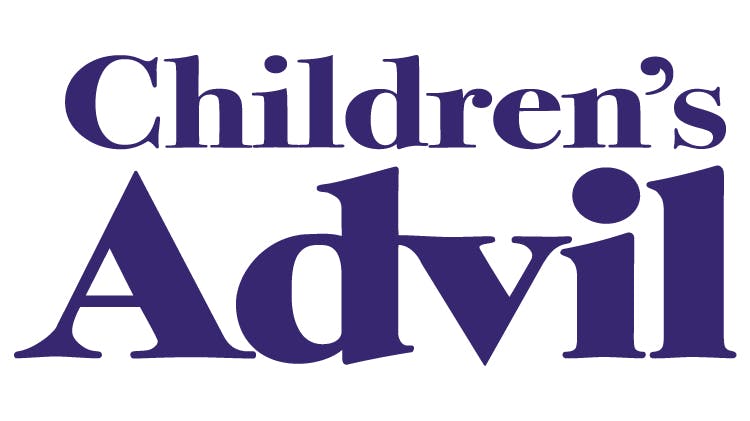Trust Children’s Advil Cold & Flu Multi-symptom to relieve pediatric sore throat, sinus pain, headache, body pain, fever and other symptoms due to cold or flu1

Children’s Advil Cold & Flu Multi-symptom works tirelessly to relieve cold and flu symptoms1
With clinically proven safety and efficacy when used as directed, Children’s Advil Cold & Flu Multi-symptom is available in an oral suspension containing 100 mg ibuprofen, 15 mg pseudoephedrine hydrochloride and 1 mg chlorpheniramine maleate per 5mL.The suspension is designed for children to help manage sore throat, sinus pain, headache, fever and minor body aches and pains due to the common cold and flu. It is a non-prescription analgesic/antipyretic, nasal decongestant, and antihistamine preparation (see Children’s Advil Cold & Flu Multi-symptom Detail section for more information)1
Children’s Advil Cold & Flu Multi-symptom is formulated for children 6–12 years old and is available in a translucent deep red, berry flavour to suit your patients preference and cold and flu relief needs.1
Ibuprofen is the non-steroidal anti-inflammatory ingredient in Children’s Advil Cold & Flu Multisymptom1
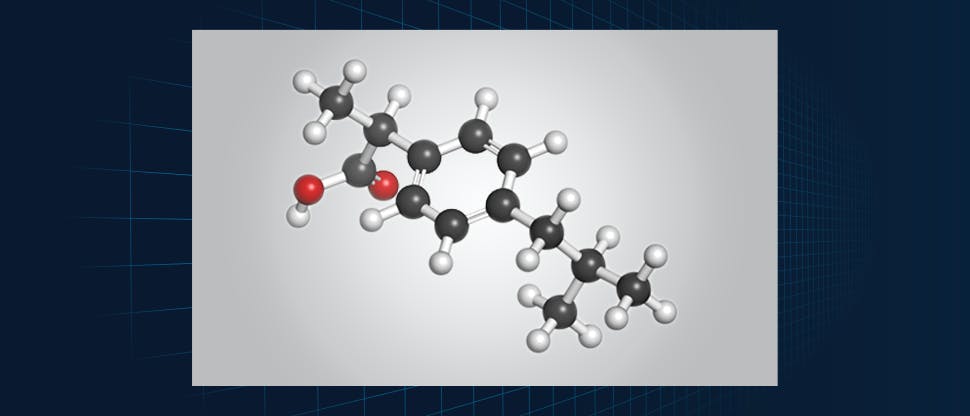
Children’s Advil products contain ibuprofen – a nonsteroidal anti-inflammatory drug (NSAID)
Ibuprofen is the key active ingredient in the Children’s Advil Cold & Flu Multi-symptom product that relieves pain and reduces fever. Like all NSAIDs, ibuprofen is an analgesic, antipyretic, and anti-inflammatory.1
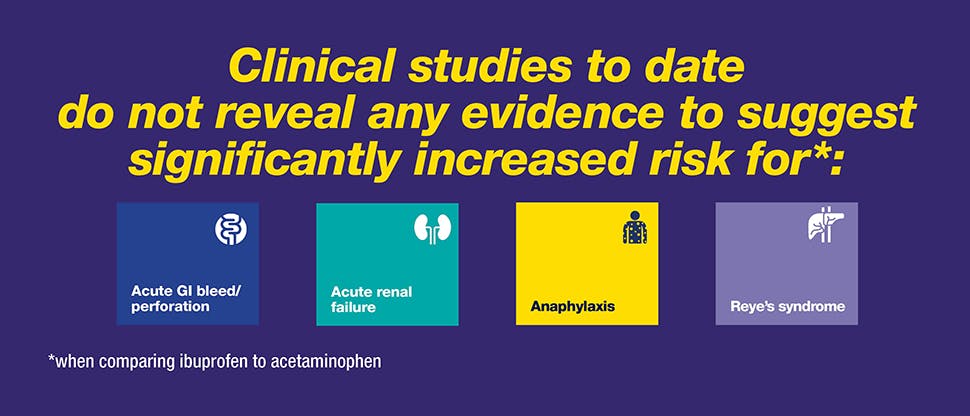
Overall & GI Tolerability Profile in Children
Ibuprofen has a similar safety profile to acetaminophen in children
Ibuprofen has been studied widely in children with over 100,000 enrolled in clinical trials.2-4 Ibuprofen is well tolerated in children at doses of 20–30 mg/kg/day and higher as demonstrated in the Boston University Fever Study. Ideally dosing should be based on weight (see Advil Pediatric Drops product details for dosing chart).
Studies conducted to date have not demonstrated pediatric-specific problems that would limit the usefulness of ibuprofen in children 4 months and older.2 The safety findings of the Boston University Fever Study (BUFS) are concordant with those of the Children’s Analgesic Medicine Project (CAMP)**:1
Children’s Analgesic Medicine Project (CAMP), 1999 (Ashraf et al.)2**
- Within both age groups, <2 years and ≥2 to <12 years, the incidence rates for specific adverse effects (AE) for ibuprofen and acetaminophen, including abdominal pain, insomnia, and hyperkinesia were rare and generally <1%.
- The absence of serious adverse events and rare, non-serious events in children including those <2 and those ≥2 years of age confirms the safety of ibuprofen
Boston University Fever Study (BUFS), 2003 (Lesko et al.)3**
- Among ibuprofen-treated children (n=55,785), the observed risk of gastrointestinal bleeding, 7.2 per 100,000 (95% confidence interval, 2 to 18 per 100,000), was not significantly different (p=0.31) from the risk among acetaminophen-treated children (n=28,130), 0 per 100,000 (95% confidence interval, 0 to 11 per 100,000).
- There were no hospitalizations for acute renal failure or anaphylaxis; the upper 95% confidence bound for the risk of either of these outcomes was 5.4 per 100,000 ibuprofen-treated children.
GI = gastrointestinal
** Ashraf et al., 1999 conducted a multicentre, all-comers, open-label, nonrandomized, multiple dose, actual use prospective study comparing the safety of ibuprofen suspension with acetaminophen suspension in children with fever and/or pain. A total of 424 pediatricians enrolled children at 69 US clinics; 14,281 were <2 years of age and 15,863 were 2 to <12 years of age. Children aged 1 month to 18 years were studied.
Lesko et al., 2003 conducted a randomized, double-blind study that assessed the risk of rare but serious adverse events after the use of ibuprofen suspension in febrile children between 6 months and 12 years of age. The study evaluated a total of 83,915 children enrolled by 1735 pediatricians, family physicians, and general practitioners in the United States. Children were randomly assigned to receive ibuprofen suspension 5 mg/kg (N=27,948), ibuprofen suspension 10 mg/kg (N=27,837), or acetaminophen suspension 12 mg/kg (N=28,130). Medications were given every 4 to 6 hours, as needed, for a total of up to five doses per day. The study recorded hospitalizations for acute GI bleeding, acute renal failure, and anaphylaxis and monitored for the occurrence of Reye’s syndrome. Four weeks after enrolment, parents were contacted to ascertain the occurrence of serious adverse medical events.

GI bleeding profile in Children
No significant difference in hospitalizations for gastrointestinal (GI) bleeding between ibuprofen and acetaminophen was observed:2
Pediatrics, 1999 (Lesko et al.)5*
- The risk of hospitalization with acute gastrointestinal bleeding among all Children <2 years old, regardless of antipyretic assignment, was 11 per 100,000 (95% CI, 2.2–32 per 100,000). Among children randomized to ibuprofen, the risk was 17 per 100,000 (95% CI, 3.5–49 per 100,000).
- This risk did not vary significantly by ibuprofen dose, nor was it significantly greater than the corresponding risk among children randomized to receive acetaminophen (0 per 9127; 95% CI, 0–33 per 100,000; P 5.6).
* A practitioner-based, randomized clinical trial. A total of 27,065 febrile children were randomized to receive acetaminophen (12 mg/kg), ibuprofen (5 mg/kg), or ibuprofen (10 mg/kg). Rates of hospitalization for acute gastrointestinal bleeding, acute renal failure, anaphylaxis, Reye’s syndrome, asthma, bronchiolitis, and vomiting/gastritis were compared by randomization group. The risk of hospitalization with any diagnosis in the 4 weeks after enrolment was 1.4% (95% confidence interval, 1.3%–1.6%) and did not vary by antipyretic assignment. These data do not provide any information on the safety of these medications when used for prolonged periods or when used together, regardless of duration.
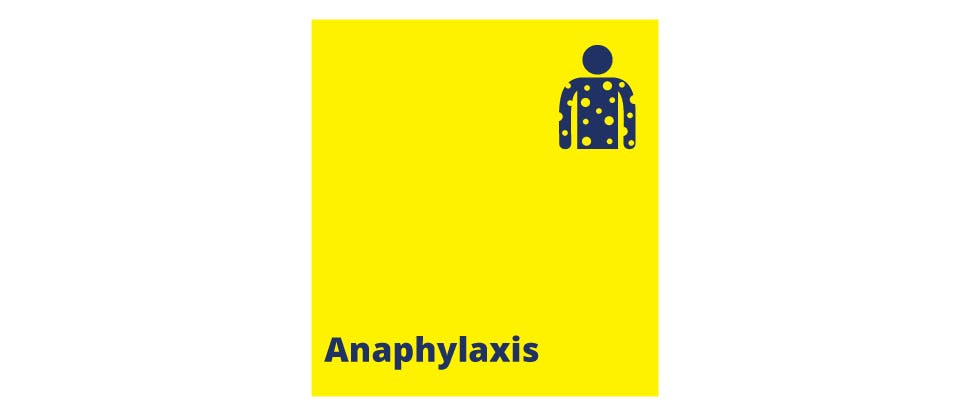
Anaphylaxis profile
Observed risk for anaphylaxis in children treated with ibuprofen:
Boston University Fever Study (BUFS), 2003 (Lesko et al.)4**
- Observed risk of anaphylaxis for each among 55,785 children was 0 per 100,000 (95% CI, 0–5.4 per 100,000)
Children’s Analgesic Medicine Project (CAMP), 1999 (Ashraf et al.)3**
- Amongst the study participants: 14,281 children <2 years old or 15,863 children ≥2 or <12; there were no reported cases of anaphylaxis in the ibuprofen or acetaminophen treatment groups
** Lesko et al., 1995 conducted a randomized, double-blind study that assessed the risk of rare but serious adverse events after the use of ibuprofen suspension in febrile children between 6 months and 12 years of age. The study evaluated a total of 83,915 children enrolled by 1735 pediatricians, family physicians, and general practitioners in the United States. Children were randomly assigned to receive ibuprofen suspension 5 mg/kg (N=27,948), ibuprofen suspension 10 mg/kg (N=27,837), or acetaminophen suspension 12 mg/kg (N=28,130). Medications were given every 4 to 6 hours, as needed, for a total of up to five doses per day. The study recorded hospitalizations for acute GI bleeding, acute renal failure, and anaphylaxis and monitored for the occurrence of Reye’s syndrome. Four weeks after enrolment, parents were contacted to ascertain the occurrence of serious adverse medical events.
Ashraf et al., 1999 conducted a multicentre, all-comers, open-label, nonrandomized, multiple dose, actual use prospective study comparing the safety of ibuprofen suspension with acetaminophen suspension in children with fever and/or pain. A total of 424 pediatricians enrolled children at 69 US clinics; 14,281 were <2 years of age and 15,863 were 2 to <12 years of age. Children aged 1 month to 18 years were studied.
![[Icons of Kidney with copy as stated beside]](https://i-cf65.ch-static.com/content/dam/cf-consumer-healthcare/health-professionals/en_CA/pain-relief/child-advil/Renal%20Safety%20in%20Children_ENGLISH_970x416.jpg?auto=format)
Renal Safety Profile in Children
There was no observable risk of acute renal failure in children treated with ibuprofen:
Boston University Fever Study (BUFS), 2003 (Lesko et al.)4**
- Observed risk of acute renal failure for each among 55,785 children was 0 per 100,000 (95% CI, 0–5.4 per 100,000)
- Renal impairment in adult ibuprofen users occurs primarily among patients with preexisting renal disease or other conditions associated with low intravascular volume or low cardiac output.
- It is unclear how this data applies to children and is often not comparable due to the absence of many factors (i.e., tobacco, alcohol, diuretic use, chronic renal failure, and congestive heart failure).
Children’s Analgesic Medicine Project (CAMP), 1999 (Ashraf et al.)3**
- Amongst the study participants: 14,281 children <2 years old or 15,863 children ≥2 or <12; there were no reported cases of acute renal failure in the ibuprofen or acetaminophen treatment groups
** Lesko et al., 2003 conducted a randomized, double-blind study that assessed the risk of rare but serious adverse events after the use of ibuprofen suspension in febrile children between 6 months and 12 years of age. The study evaluated a total of 83,915 children enrolled by 1735 pediatricians, family physicians, and general practitioners in the United States. Children were randomly assigned to receive ibuprofen suspension 5 mg/kg (N=27,948), ibuprofen suspension 10 mg/kg (N=27,837), or acetaminophen suspension 12 mg/kg (N=28,130). Medications were given every 4 to 6 hours, as needed, for a total of up to five doses per day. The study recorded hospitalizations for acute GI bleeding, acute renal failure, and anaphylaxis and monitored for the occurrence of Reye’s syndrome. Four weeks after enrolment, parents were contacted to ascertain the occurrence of serious adverse medical events.
Ashraf et al., 1999 conducted a multicentre, all-comers, open-label, nonrandomized, multiple dose, actual use prospective study comparing the safety of ibuprofen suspension with acetaminophen suspension in children with fever and/or pain. A total of 424 pediatricians enrolled children at 69 US clinics; 14,281 were <2 years of age and 15,863 were 2 to <12 years of age. Children aged 1 month to 18 years were studied.
![[Parents with their children]](https://i-cf65.ch-static.com/content/dam/cf-consumer-healthcare/health-professionals/en_CA/pain-relief/child-advil/Parents%20with%20kids_970x416.png?auto=format)
Clinically proven efficacy for relief for fever, pain and other symptoms due to the common cold and flu in children1
Multiple studies using a dose range from 5–10 mg/kg of ibuprofen has been shown to lower fever and manage pain in children, including pain due to colds and flu.2 Many studies have also been conducted evaluating the efficacy of ibuprofen in managing mild to moderate pain arising from:1,2
- Sore throat pain
- Otitis media
- Immunization
- Post surgery
Ibuprofen for children provides up to 8 hours of fever relief, which results in less frequent dosing vs. acetaminophen (every 4–6 hours).2,6
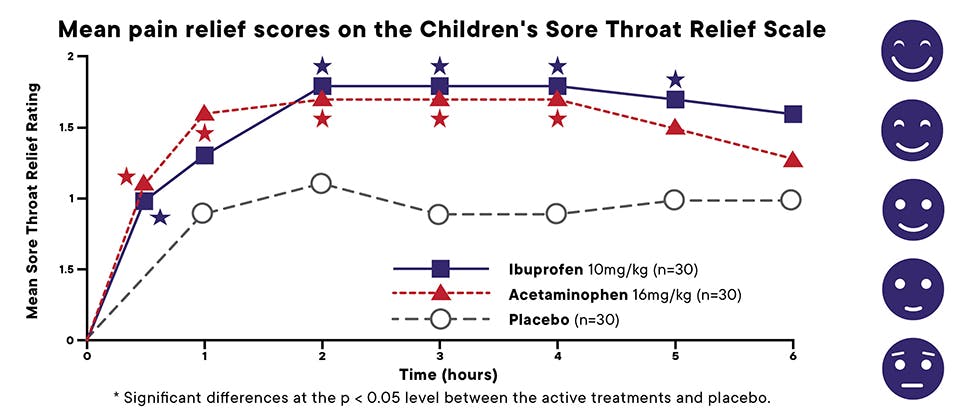
Clinically proven efficacy in sore throat pain in children
Ibuprofen offered statistically significant effective sore throat relief compared to placebo and longer duration of pain relief compared to acetaminophen in children as seen in the following study:7
Clinical Pharmacology and Therapeutics, 1993 (Schachtel BP et al.)
- A double-blind, single dose parallel study was conducted to evaluate treatment of sore throat pain in children. Statistically significant differences compared to placebo were noted at 30 minutes and from 2–5 hours. The acetaminophen treatment group notes statistically significant differences from 30 minutes to 4 hours. This may suggest that ibuprofen offers longer duration of pain relief than acetaminophen7*
* Schachtel BP et al., 1993 conducted a double-blind, placebo-controlled, single-dose parallel study in 116 children from 2 to 12 years of age with acute sore throat. Measurements were done at 30 minutes and every hour thereafter for 6 hours. Children assessed pain intensity with a pain thermometer and pain relief with a smiley-face scale. The parent and pediatrician assessed pain intensity and change in pain; the parent also provided an overall evaluation at 6 hours. The children rated ibuprofen and acetaminophen as significantly effective compared with placebo (p < 0.05) on both scales at most posttreatment time points and overall. The parent and pediatrician also rated both active medications as significantly different from placebo on both of their scales (p < 0.05) at several time points and overall.
![[Amanda smiling]](https://i-cf65.ch-static.com/content/dam/cf-consumer-healthcare/health-professionals/en_CA/pain-relief/child-advil/Amanda_970x416.png?auto=format)
Amanda needs safe, fast and effective relief for her fever and cold and flu symptoms.
Amanda is a busy 6 year old girl who loves music and gymnastics. She is missing class today after her mom confirmed that she has a temperature. Amanda has also started to complain of a sore throat and feeling unwell. Her mom wants to relieve her daughters’ cold and flu symptoms with a safe, effective option and is seeking some advice on what product to choose.*
Her symptoms: Fever and sore throat.
Children’s Advil Cold & Flu Multi-symptom is an oral suspension designed to relieve fever and pain in children 6–12 years old. Doses may be repeated every 6 hours while symptoms persist and up to 4 doses per day or as directed by a doctor. The dosing is flexible based on age or weight.1
* Fictional case study.
Recommend Children’s Advil to manage your pediatric patients’ acute pain and fever
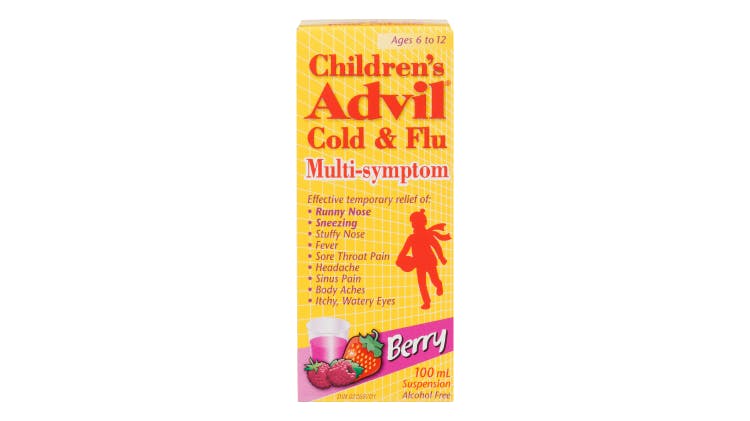
Children’s Advil Cold & Flu Multi-symptom
Children’s Advil Cold & Flu Multi-symptom works tirelessly to relieve cold and flu symptoms1
